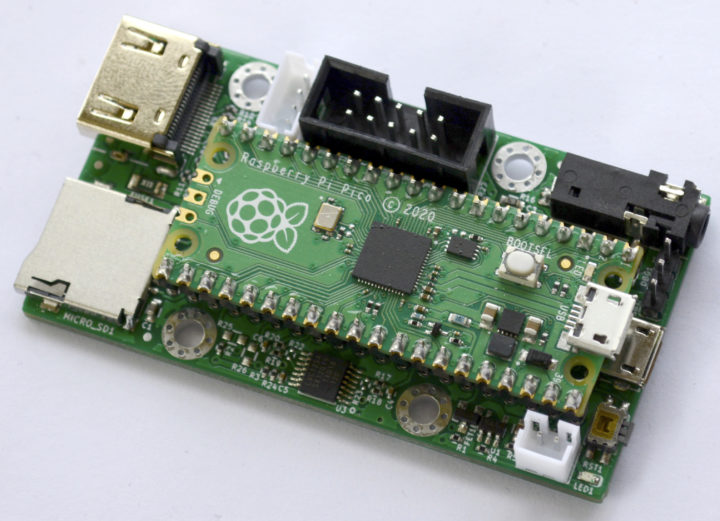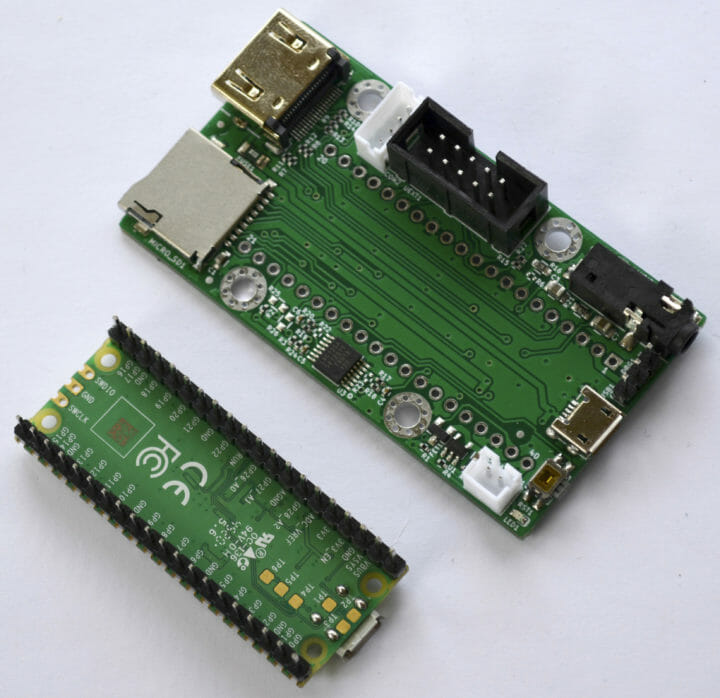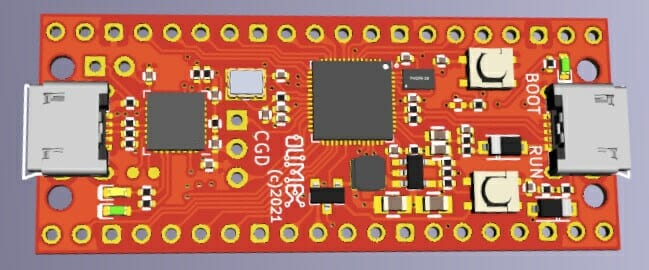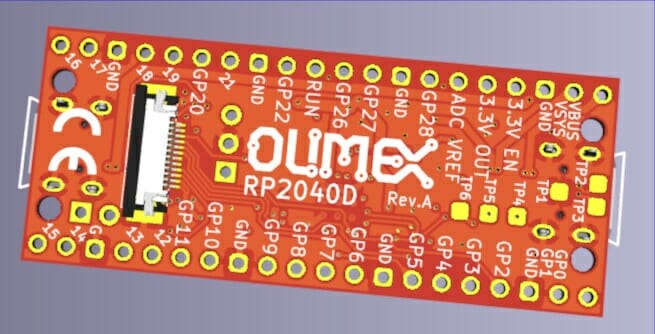We previously wrote it was possible to create a Raspberry Pi RP2040 board with HDMI using DVI and programmable IOs to output video up to 640×480 at 60 Hz with the microcontroller’s Cortex-M0+ cores clocked at 252 MHz.
At the time, we also noted Olimex was working on such a board with RP2040-PICO-PC designed to create a small Raspberry Pi RP2040 computer with HDMI/DVI video output. The Bulgarian company has now manufactured the first prototype, but due to supply issues with the Raspberry Pi Pico board, they also designed their own RP2040-PICO module since they’ve got a reel of Raspberry Pi RP2040 microcontrollers.
RP2040-PICO-PC small computer board
Specifications:
- Support for Raspberry Pi Pico board
- Storage – MicroSD card
- Video Output – HDMI port with DVI signal (note no audio through this interface)
- Audio output – 3.5mm audio jack
- Expansion
- UEXT connector with UART, SPI, I2C, 3.3V, and GND to attach external modules or sensors from Olimex
- Grove compatible 4-pin JST2.0 header with I2C + power signals
- Debugging – Debug connector for Serial adapter
- Misc – Reset button
- Power Supply
- 5V via Micro USB port
- 2-pin header for LiPo battery for handheld operation and power backup
- Dimensions – Small 😉
You should indeed be able to use it as a small computer with HDMI video output, speakers connected to the 3.5mm audio jack, storage using the 2MB SPI flash and/or a MicroSD card, as well as keyboard and mouse via the micro USB 1.1 port on the Raspberry Pi Pico board.
Obviously, it won’t be able to run a typical operating system like Linux, but it might be possible to make a simple retro-gaming console, a basic digital signage player, or program directly on Raspberry Pi Pico without the need for a separate computer.
Olimex RP2040-PICO-PC sells for 12 Euros without the Raspberry Pi Pico board
RP2040-Py module compatible with Raspberry Pi Pico
As noted in the introduction, the hardware is ready, but it’s not possible to purchase enough Raspberry Pi Pico boards for production, so Olimex designed the RP2040-Py module compatible with Raspberry Pi Pico, but adding some improvements:
- Additional USB micro connector on the right hand for power
- Added uUEXT connector on the bottom of the board
- Added Reset button
- Optional JTAG USB debugger
- DC-DC power supply with 3.3V up to 2A (if the 5V source can provide)
The board still comes with the same Raspberry Pi RP2040 microcontroller, 2MP SPI flash, I/O headers, and Micro USB connector as found on the Pico board to make it a drop-in replacement.
There will be three versions of RP2040-Py board/module:
- Basic (5 Euros) identical to Raspberry Pi Pico board but with higher current DCDC power supply, uUEXT connector, and Reset button
- Basic+ (8 Euros) based on the Basic version plus soldered headers and additional micro USB for power in order to use the other as a USB device or USB host.
- Debug (19 Euros) which builds on the Basic+ model but is populated with JTAG parts for debugging using OpenOCD/Eclipse/Visual Studio, ARM (Keil) IDE, or IAR Systems EW.
The product is expected to start in a few weeks, so both RP2040-PICO-PC and RP2040-Py should be up for sale in early May.
You may find a few more details in the announcement on Olimex blog.

Jean-Luc started CNX Software in 2010 as a part-time endeavor, before quitting his job as a software engineering manager, and starting to write daily news, and reviews full time later in 2011.
Support CNX Software! Donate via cryptocurrencies, become a Patron on Patreon, or purchase goods on Amazon or Aliexpress








